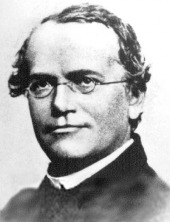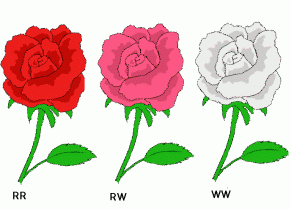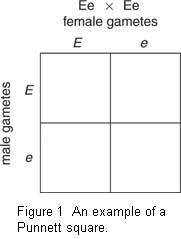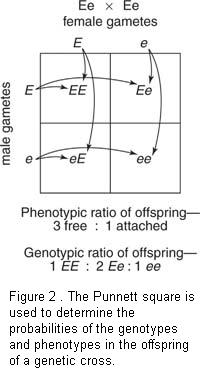Introduction to Genetics

Genetics is the study of how genes bring about characteristics, or traits, in living things and how those characteristics are inherited. Genes are portions of DNA molecules that determine characteristics of living things. Through the processes of meiosis and reproduction, genes are transmitted from one generation to the next.
The Augustinian monk Gregor Mendel developed the science of genetics. Mendel performed his experiments in the 1860s and 1870s, but the scientific community did not accept his work until early in the twentieth century. Because the principles established by Mendel form the basis for genetics, the science is often referred to as Mendelian genetics. It is also called classical genetics to distinguish it from another branch of biology known as molecular genetics.
Mendel believed that factors pass from parents to their offspring, but he did not know of the existence of DNA. Modern scientists accept that genes are composed of segments of DNA molecules that control discrete hereditary characteristics.
Most complex organisms have cells that are diploid. Diploid cells have a double set of chromosomes, one from each parent. For example, human cells have a double set of chromosomes consisting of 23 pairs, or a total of 46 chromosomes. In a diploid cell, there are two genes for each characteristic. In preparation for sexual reproduction, the diploid number of chromosomes is reduced to a haploid number. That is, diploid cells are reduced to cells that have a single set of chromosomes. These haploid cells are gametes, or sex cells, and they are formed through meiosis. When gametes come together in sexual reproduction, the diploid condition is reestablished.
The offspring of sexual reproduction obtain one gene of each type from each parent. The different forms of a gene are called alleles. In humans, for instance, there are two alleles for earlobe construction. One allele is for earlobes that are attached, while the other allele is for earlobes that hang free. The type of earlobe a person has is determined by the alleles inherited from the parents.
The set of all genes that specify an organism's traits is known as the organism's genome. The genome for a human cell consists of about 100,000 genes. The gene composition of a living organism is its genotype. For a person's earlobe shape, the genotype may consist of two genes for attached earlobes, or two genes for free earlobes, or one gene for attached and one gene for free earlobes.
The expression of the genes is referred to as the phenotype of a living thing. If a person has attached earlobes, the phenotype is “attached earlobes.” If the person has free earlobes, the phenotype is “free earlobes.” Even though three genotypes for earlobe shape are possible, only two phenotypes (attached earlobes and free earlobes) are possible.
The two paired alleles in an organism's genotype may be identical, or they may be different. An organism's condition is said to be homozygous when two identical alleles are present for a particular characteristic. In contrast, the condition is said to be heterozygous when two different alleles are present for a particular characteristic. In a homozygous individual, the alleles express themselves. In a heterozygous individual, the alleles may interact with one another, and in many cases, only one allele is expressed.
When one allele expresses itself and the other does not, the one expressing itself is the dominant allele. The overshadowed allele is the recessive allele. In humans, the allele for free earlobes is the dominant allele. If this allele is present with the allele for attached earlobes, the allele for free earlobes expresses itself, and the phenotype of the individual is “free earlobes.” Dominant alleles always express themselves, while recessive alleles express themselves only when two recessive alleles exist together in an individual. Thus, a person having free earlobes can have one dominant allele or two dominant alleles, while a person having attached earlobes must have two recessive alleles.
Inheritance Patterns
Mendel was the first scientist to develop a method for predicting the outcome of inheritance patterns. He performed his work with pea plants, studying seven traits: plant height, pod shape, pod color, seed shape, seed color, flower color, and flower location. Pea plants pollinate themselves. Therefore, over many generations, pea plants develop individuals that are homozygous for particular characteristics. These populations are known as pure lines.
In his work, Mendel took pure-line pea plants and cross-pollinated them with other pure-line pea plants. He called these plants the parent generation. When Mendel crossed pure-line tall plants with pure-line short plants, he discovered that all the plants resulting from this cross were tall. He called this generation the F1 generation (first filial generation). Next, Mendel crossed the offspring of the F1 generation tall plants among themselves to produce a new generation called the F2 generation (second filial generation). Among the plants in this generation, Mendel observed that three-fourths of the plants were tall and one-fourth of the plants were short.
Mendel's laws of genetics
Mendel conducted similar experiments with the other pea plant traits. Over many years, he formulated several principles that are known today as Mendel's laws of genetics. His laws include the following:
Mendel's law of dominance: When an organism has two different alleles for a trait, one allele dominates.
Mendel's law of segregation: During gamete formation by a diploid organism, the pair of alleles for a particular trait separate, or segregate, during the formation of gametes (as in meiosis).
Mendel's law of independent assortment: The members of a gene pair separate from one another independent of the members of other gene pairs. (These separations occur in the formation of gametes during meiosis.)
Mendelian crosses
An advantage of genetics is that scientists can predict the probability of inherited traits in offspring by performing a genetic cross (also called a Mendelian cross). To predict the possibility of an individual trait, several steps are followed. First, a symbol is designated for each allele in the gene pair. The dominant allele is represented by a capital letter and the recessive allele by the corresponding lowercase letter, such as E for free earlobes and e for attached earlobes. For a homozygous dominant individual, the genotype would be EE; for a heterozygous individual, the genotype would be Ee; and for a homozygous recessive person, the genotype would be ee.
The next step in performing a genetic cross is determining the genotypes of the parents and the genotype of the gametes. A heterozygous male and a heterozygous female to be crossed have the genotypes of Ee and Ee. During meiosis, the allele pairs separate. A sperm cell contains either an E or an e, while the egg cell also contains either an E or an e.
To continue the genetics problem, a Punnett square is used. A Punnett square is a boxed figure used to determine the probability of genotypes and phenotypes in the offspring of a genetic cross. The possible gametes produced by the female are indicated at the top of the square, while the possible gametes produced by the male are indicated at the left side of the square. Figure 1 shows the Punnett square for the earlobe example.
Continuing, all of the possible combinations of alleles are considered. This is done by filling in each square with the alleles above it and at its left. This is done as shown in Figure 2 .
From the Punnett square, the phenotype of each possible genotype can be determined. For example, the offspring having EE, Ee, and Ee will have free earlobes. Only the offspring with the genotype ee will have attached earlobes. Therefore, the ratio of phenotypes is three with free earlobes to one with attached earlobes (3:1). The ratio of genotypes is 1:2:1 (1 EE : 2 Ee : 1 ee).
Principals of Genetics

Mendel's studies have provided scientists with the basis for mathematically predicting the probabilities of genotypes and phenotypes in the offspring of a genetic cross. But not all genetic observations can be explained and predicted based on Mendelian genetics. Other complex and distinct genetic phenomena may also occur. Several complex genetic concepts, described in this section, explain such distinct genetic phenomena as blood types and skin color.
Incomplete dominance
In some allele combinations, dominance does not exist. Instead, the two characteristics blend. In such a situation, both alleles have the opportunity to express themselves. For instance, snapdragon flowers display incomplete dominance in their color. There are two alleles for flower color: one for white and one for red. When two alleles for white are present, the plant displays white flowers. When two alleles for red are present, the plant has red flowers. But when one allele for red is present with one allele for white, the color of the snapdragons is pink.
However, if two pink snapdragons are crossed, the phenotype ratio of the offspring is one red, two pink, and one white. These results show that the genes themselves remain independent; only the expressions of the genes blend. If the gene for red and the gene for white actually blended, pure red and pure white snapdragons could not appear in the offspring.
Multiple alleles
In certain cases, more than two alleles exist for a particular characteristic. Even though an individual has only two alleles, additional alleles may be present in the population. This condition is multiple alleles.
An example of multiple alleles occurs in blood type. In humans, blood groups are determined by a single gene with three possible alleles: A, B, or O. Red blood cells can contain two antigens, A and B. The presence or absence of these antigens results in four blood types: A, B, AB, and O. If a person's red blood cells have antigen A, the blood type is A. If a person's red blood cells have antigen B, the blood type is B. If the red blood cells have both antigen A and antigen B, the blood type is AB. If the red blood cells have neither antigen A nor antigen B, the blood type is O.
The alleles for type A and type B blood are co-dominant; that is, both alleles are expressed. However, the allele for type O blood is recessive to both type A and type B. Because a person has only two of the three alleles, the blood type varies depending on which two alleles are present. For instance, if a person has the A allele and the B allele, the blood type is AB. If a person has two A alleles, or one A and one O allele, the blood type is A. If a person has two B alleles or one B and one O allele, the blood type is B. If a person has two O alleles, the blood type is O.
Polygenic inheritance
Although many characteristics are determined by alleles at a single place on the chromosome, some characteristics are determined by an interaction of genes on several chromosomes or at several places on one chromosome. This condition is polygenic inheritance.
An example of polygenic inheritance is human skin color. Genes for skin color are located in many places, and skin color is determined by which genes are present at these multiple locations. A person with many genes for dark skin will have very dark skin color, and a person with multiple genes for light skin will have very light skin color. Many people have some genes for light skin and some for dark skin, which explains why so many variations of skin color exist. Height is another characteristic probably reflecting polygenic characteristics.
Gene linkage
A chromosome has many thousands of genes; there are an estimated 100,000 genes in the human genome. Inheritance involves the transfer of chromosomes from parent to offspring through meiosis and sexual reproduction. It is common for a large number of genes to be inherited together if they are located on the same chromosome. Genes that are inherited together are said to form a linkage group. The concept of transfer of a linkage group is gene linkage.
Gene linkage can show how close two or more genes are to one another on a chromosome. The closer the genes are to each other, the higher the probability that they will be inherited together. Crossing over occurs during meiosis, but genes that are close to each other tend to remain together during crossing over.
Sex linkage
Among the 23 pairs of chromosomes in human cells, one pair is the sex chromosomes. (The remaining 22 pairs of chromosomes are referred to as autosomes.) The sex chromosomes determine the sex of humans. There are two types of sex chromosomes: the X chromosome and the Y chromosome. Females have two X chromosomes; males have one X and one Y chromosome. Typically, the female chromosome pattern is designated XX, while the male chromosome pattern is XY. Thus, the genotype of the human male would be 44 XY, while the genotype of the human female would be 44 XX (where 44 represents the autosomes).
In humans, the Y chromosome is much shorter than the X chromosome. Because of this shortened size, a number of sex-linked conditions occur. When a gene occurs on an X chromosome, the other gene of the pair probably occurs on the other X chromosome. Therefore, a female usually has two genes for a characteristic. In contrast, when a gene occurs on an X chromosome in a male, there is usually no other gene present on the short Y chromosome. Therefore, in the male, whatever gene is present on the X chromosome will be expressed.
An example of a sex-linked trait is colorblindness. The gene for colorblindness is found on the X chromosome. A woman is rarely colorblind because she usually has a dominant gene for normal vision on one of her X chromosomes. However, a male has the shortened Y chromosome; therefore, he has no gene to offset a gene for colorblindness on the X chromosome. As a result, the gene for colorblindness expresses itself in the male.
Another example of sex-linked inheritance is the blood disease hemophilia. In hemophilia, the blood does not clot normally because an important blood-clotting protein is missing. The gene for hemophilia occurs on the X chromosome. As females have two X chromosomes, one X chromosome usually has the gene for normal blood clotting. Therefore, the female may be a carrier of hemophilia but normally does not express hemophilia. Males have no offsetting gene on the Y chromosome, so the gene for hemophilia expresses itself in the male. This is why most cases of hemophilia occur in males.


